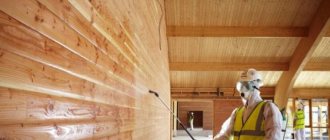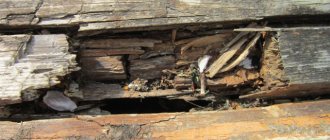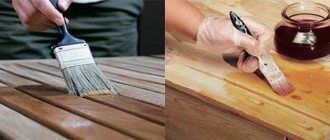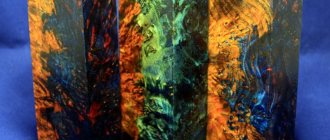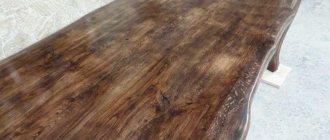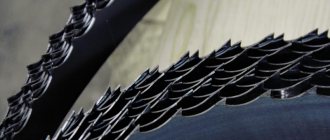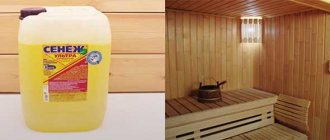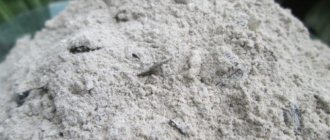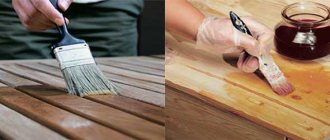Main goals of stabilization
The primary task is to protect the wood from the negative effects of moisture.
After impregnation, the fibers become impervious to all kinds of liquids and chemical treatments. They do not increase, do not lose their performance characteristics, and retain their shape and color. This procedure is not just impregnation, but filling the entire available space between the fibers. For this purpose, protective compounds are used that clog pores.
Stabilization helps improve the consumer qualities of wood. The best effect can be achieved with compositions that have the ability to polymerize. Most often used for this purpose:
- natural resins,
- polymers,
- paints and varnishes,
- all kinds of oils.
Peculiarities
Epoxy resin is a purely synthetic compound substance in liquid form. Undiluted, it can be stored for a very long time, therefore, before pouring into molds, it is mixed with another liquid - a hardener - in the proportion as indicated on the packaging. Only such mixing starts the polymerization processes, which means that the mixed mass must be given the desired shape as quickly as possible.
Products made from epoxy resin are used in a wide variety of industries, including even electronics and aviation, but in combination with wood, this material is, of course, the most practical for the DIY production of home furniture or souvenirs and small utensils.
Epoxy resin in combination with wood is good because it initially has a fluid form and is able to fill any cracks and chips, leveling out the unevenness of the wood purely under the influence of the laws of physics. After hardening, its surface lends itself well to grinding and polishing; grooves can be turned into it or holes can be drilled. In this case, the material can be purchased in a specific color or completely transparent, and the latter can be tinted with commercially available dyes.
Using epoxy glue.
Now let's look at common applications with epoxy glue in woodworking, including gluing grooves, filling pores and cracks, and gluing dissimilar materials. Epoxy glue, due to its fluidity, fills voids in joints. Having mixed the resin and hardener in certain proportions, apply the glue to the bonding areas using a disposable brush or spatula, as shown in (Photo D). Press the glued joint and leave it in a warm place until it dries completely, 24 hours. For knots, cracks, and other imperfections I use a mixture of glue and sanding dust. If the crack or gap is wide and long, place adhesive tape under the bottom of the workpiece as shown in (Photo E).
Apply epoxy into the crack with a putty knife. If the glue continues to soak in, leave the product for a while, let the glue dry a little, and then continue repairing the flaw. Two tips that may be helpful. Create a mixture of epoxy glue and sanding dust. Then apply this mixture to the surface (Photo F). Epoxy putty can repair damaged workpieces and fills pores in the ends of products well. Mix equal amounts of resin and hardener together, then use a spatula to apply to the damaged areas or ends of the workpiece (Photo G).
Why do you need to impregnate wood?
Wood is in great demand due to its strength, environmental friendliness, hygroscopicity, sound insulation and heat capacity. In addition, the beauty and ease of wood processing place it much higher than other materials in the manufacture of furniture, construction, finishing of houses and industrial premises.
Untreated wood is destroyed under the influence of many factors, so numerous impregnations and antiseptics have been created that protect the material:
- from fungi,
- from mold,
- from rot,
- from insects,
- from ultraviolet radiation,
- from temperature changes,
- from precipitation,
- from various injuries,
- from penetration and sedimentation of dirt.
Examples of materials
The most popular type is epoxy-polyurethane varnish. It forms a coating that is resistant to corrosion and other negative environmental impacts. Withstands temperature changes from –200 to +120° C. Thanks to its components, it reliably insulates the surface from moisture, repels liquid and dirt. After complete drying, the layer is very durable and can withstand severe mechanical and electrical loads, as well as vibrations.
Elakor-ED is one example of varnishes that are intended exclusively for creating floor coverings. Easily applied to any prepared surface. It makes it possible to literally make floors durable, wear-resistant and completely sealed in just 1 day. Numerous studies have shown that such a varnished surface does not react with acids, alkalis and petroleum products. Therefore, you can use it not only in your own home, but also in production.
"Elakor-ED" is intended for pouring the last layers of epoxy coatings when solving the following problems:
- creating a 3D floor;
- decorating the floor covering with glitters and chips;
- obtaining a glossy finish;
- installation of chemical-resistant surfaces.
Selection of material
In order for a particular material to be freely used when pouring products, it is necessary that the epoxy has good adhesion to this material. In simple words, they must “stick together” well. Otherwise, peeling may occur inside the polymer, which will negatively affect the appearance of the product. In this regard, wood combines well with resin, but several nuances of pouring must be taken into account.
To fill floors, you need to focus on the strength indicator. For the manufacture of tabletops, the fluidity of the compound is important, and decorations and souvenirs are excellent from transparent resin. The epoxy composition is easy to prepare at home. The resin is usually sold as two components in a kit. The base composition may be called component “A”, and the hardener may be called component “B”. When they are mixed, a chemical reaction occurs. As a result of polymerization, a substance is formed that retains its shape and volume.
The reaction of interaction of oligomers with the hardener occurs with the release of heat. An intense reaction can cause the resin to become overheated and even boil. To avoid this, you should not work with large volumes if you do not have the skill to handle materials. The larger the volume, the more energy is released as a result of the reaction.
Another parameter on which the intensity of interaction of reagents depends is the lifetime of the resin. Many people try to choose resins that have a minimum lifetime. They motivate their choice by the fact that in this way they can reduce the hardening time of the compound, but this is a mistaken opinion.
- Firstly, the time for complete cure is independent of the pot life.
- Secondly, the long lifetime corresponds to a less intense reaction, therefore eliminating overheating of the resin.
When stirring, many air bubbles appear in the resin. If they do not come to the surface, they will remain in the frozen compound and spoil the whole picture. Experienced professionals can remove bubbles, but it is recommended that all possible measures be taken to reduce their number.
If appropriate equipment is available, vacuuming is used. By lowering the air pressure above the resin, an accelerated release of bubbles from the resin is achieved. The remaining bubbles are dealt with after pouring by heating the epoxy with a hairdryer.
Working with epoxy resin at home - a detailed guide for beginners
We will immediately bring newcomers up to speed. All epoxy resins can be divided into two large groups: pure and modified. Pure epoxy is attractive due to its price, but you can immediately forget about any acceptable result of creativity with it. This is also not the best option for practicing initial skills and is worth saving on. And that's why.
Pure epoxies - a classic example is ED-20 resin - are used for technical purposes. They reinforce fiberglass, fill printed circuit boards, stabilize large cracks in wood, etc. At first glance, technical epoxy behaves like an ordinary resin. But it is thicker, flows worse, air bubbles form in it abundantly, which come out very poorly. To obtain a fill without bubbles frozen in the thickness of the resin, the composition must be vacuumized - this is difficult and does not solve the problem 100%. The resin itself can only be prepared in limited portions. When mixing a large volume at once, a lot of heat is generated and the composition can boil. By the way, any resins are susceptible to this, but here the risks are higher.
Technical resins dry quickly. The fill can harden on average in two to three hours. Some would see this as a plus, but it is not. Firstly, rapid polymerization does not leave time for the natural release of bubbles. Secondly, there is a sharp imbalance of internal stresses, which is why the fillings often burst. Taking into account all these factors, it is possible to obtain at least an acceptable result only with very thin fills up to 4-5 mm. But even this will not save you from the last problem: pure resins cannot withstand ultraviolet radiation and quickly turn yellow.
Modified epoxies are resins with additives that improve the casting properties of the material and the aesthetics of the final result. We have talked about the disadvantages of pure resins, so we will simply list the advantages of their competitors. So, here are the main advantages of modified epoxies:
- high fluidity and good casting properties (very important when filling the pores and capillaries of wood);
- high transparency;
- low "bubbling";
- versatility: suitable for fills with thicknesses from 1 mm to several centimeters;
- high basic strength + minimal risk of spontaneous cracking;
- resistance to ultraviolet radiation (all epoxies turn yellow over time, but with high-quality compounds this does not happen so quickly, and the color change itself is not so intense).
- the ability to mix large volumes (although the risk of the mixture boiling still remains).
Is it possible to fill fresh flowers with epoxy resin? Yes, but for the result to be truly high-quality, you need to use a composition with high transparency and fluidity.
Well, there are no shortcomings - all epoxies have them.
The increased open exposure time imposes its own difficulties. Even the fastest modified resins take 6 to 12 hours to dry. During this time, the part must be carefully protected from dust, dirt and humidity fluctuations. And if with relatively small projects this is more or less solvable, then, for example, with a poured slab everything is incomparably more complicated. If this is not done, dust particles and debris will settle on the resin, and even worse, they will go into its thickness, and grinding will no longer save. A sharp jump in humidity will lead to another serious problem - the formation of an amine film, which we will discuss below.
The high fluidity of the resin also comes out sideways. It flows better into all irregularities, depressions, cracks - this is definitely a plus. But the material consumption becomes several times higher. When we talk about slabs and other large fills, sealing the formwork and creating an insulating substrate is critical. If the modified resin finds the slightest crack, it will certainly take advantage of this and begin to leak out - your workbench, floor, etc. will be filled in instead of the product. And, finally, the more modifying additives, the lower the final strength of the plastic. This should also not be forgotten in the pursuit of a resin with ideal qualities. There are also security issues - more on that below.
Types of resins for creativity
The amount of modifying additives determines the performance properties of the epoxy. Once upon a time, everything was less complicated and most of all improved resins were simply called jewelry (to be fair, this term is still in active use today). But the demand for epoxy is growing, which is what manufacturers are taking advantage of by offering different variations of their products.
Today you can find epoxy for painting, for jewelry, for small-format and large fills of different thicknesses. But such a classification is very conditional. This is not to say that this is a marketing ploy. Manufacturers, indeed, adjust the presence of specific modifiers to make the resin more suitable for certain tasks. For example, epoxies for large pours are less prone to boiling when mixed in large volumes, and resin for decorations is more transparent and better “releases” air bubbles.
Woodschool recommends!
Epoxy resins for painting and jewelry making:
- Creative ArtPro (750 g)
- medium-sized resin for painting and volumetric pouring. Highly fluid, quick-drying, does not turn yellow, releases bubbles well. The maximum thickness of a one-time fill is 10 mm. - Epoxy Crystal PLUS (580 g)
- jewelry resin with high fluidity and transparency; does not turn yellow, is not subject to cracking, and releases bubbles well. Optimal for making jewelry and volumetric fillings. - ResinArt No. 2 (1.5 kg)
is a highly transparent, medium-viscosity resin that is excellent for painting, providing good control when drawing complex objects. The product is also optimal for casting small volumetric products, pouring solid fillers, and creating thin glossy coatings. - Artline Monolith 5 Epoxy (1 kg)
- epoxy resin for creating large-format fills; The maximum thickness of a one-time poured layer is up to 50 mm. Characterized by slow polymerization (up to 5 days). - EpoximaxX MixArt Resin (1.5 kg)
- highly transparent resin for painting; Thanks to its self-leveling properties, the product is excellent for applying thin glossy finishes. - ArtEpoxy (1 kg)
- high viscosity epoxy resin is great for drawing complex objects and flat domed fills. Can be used for making jewelry and small volumetric castings. - Art-Pro Black 1.7 kg
is a very thick resin used primarily for painting abstract compositions such as “Sea”, “Space”, “Stone Cut”, etc. Epoxy provides good control over the painting and prevents the painting from bleeding during the polymerization process .
How much does epoxy resin cost?
Working with quality resins is not a cheap hobby, at least when dealing with large-scale projects. On average, the price of high-quality modified resin ranges from 1200 to 1600 rubles per kilogram. Yes, epoxy is always worked by weight, not by volume, so the main measurement is grams and kilograms.
Considering the fact that, for example, pouring full-size countertops from slabs requires tens of kg of resin, the high cost and high degree of responsibility of such work become obvious. Most of the problems that occur when pouring resin are irreversible, so before taking on the same countertops, we strongly recommend that you complete three or four smaller projects.
What are wooden slabs and why are they so valued in modern design? Read this article.
Resin preparation
By combining different volumes of polymer compound with a hardener, you can obtain all kinds of compositions for creativity, design or finishing work. The typical ratio is 10:1. It is convenient for making crafts. In order to strengthen the surface, the proportion should be 5:1.
Technologies for preparing small and large volumes of the working mixture differ. The polymerization process is accelerated by increasing the temperature. It is necessary to correctly select the components of the working substance. You need to start by heating the compound in a water bath to reduce the viscosity of the material.
Pour the hardener into the hot resin in a thin stream, stirring constantly. An amine- or anhydride-based chemical is suitable for dissolving the compound. This composition begins to harden after 30-40 minutes. Therefore, you need to work right away.
When preparing a large volume of polymer compound, plasticizers are added. Their correct content is 5-10% by weight of epoxy. This mixture should boil. A construction mixer is used for mixing. If you want to add color to the composition, add the appropriate pigment. Before mixing with the hardener, the resin is cooled to 30°C.
Mix epoxy glue.
For our purposes, epoxy adhesive comes in the form of a resin or mastic and a hardener (Photo A). Mix the correct ratio of resin and hardener (2:1, respectively) and thoroughly mix the composition in a shallow metal container, either using a stick or spatula (Photo B). Sanding dust or filler or colorant can be added to the epoxy resin before mixing it with the hardener (Photo C).
Some epoxy pastes have the consistency of thick sour cream, then the two parts can be mixed in a tin with a spoon. Other putties are squeezed out of tubes, mixed and applied using a spatula. Regardless of the type of epoxy glue, it is very important to follow the instructions, especially regarding the proper proportion. Most problems with epoxy glue are caused by an incorrect resin-hardener ratio or poor mixing; by combining the two parts together, make only as much of the mixture as you can use at one time. Use a clean container for each new batch.
Bodies of revolution
Let's look separately at the category of wood crafts. This may include jewelry, furniture items or souvenirs. What they have in common is that they are obtained by turning them on a lathe.
At first glance, it may seem that these are the most complex crafts in terms of manufacturing technology. But the high degree of adhesion of the resin makes it possible to process wood together with epoxy as a single piece.
Pine timber is used as the starting material. It usually has cracks that occur when the wood dries. These cracks will subsequently play an important role in decoration. If desired, you can distribute them using a grinder. Tinted resin is poured into the resulting cavities. To prevent it from leaking out of the end parts of the beam, it is necessary to take all possible sealing measures. Even temporary structures are suitable, because after the resin has cured they can be removed.
The piece of timber and resin is then processed on a lathe. This is just one of many examples. Here the master has the opportunity to show his imagination.
Application area
When using the material, due to the presence of epoxy resin ED-16 (in more expensive variations - ED-20), a high-strength film is formed. The product is used to cover surfaces such as parquet, doors, windows, furniture, and solid wood floors. If the surface will experience serious loads in the future, then you can safely buy an epoxy varnish mixture, which has a huge margin of safety.
It has also found application in the manufacture of souvenirs and putties. Often used for finishing metal products.
Details
Preparatory stage before applying paintwork
If the mixture is of a two-component type, then it should be properly prepared before application. A hardener should be added to the base, and then the mixture should be thoroughly mixed for 5-10 minutes. Next, you should wait a couple more minutes for the chemical reaction to complete, and at this time some types of varnishes become a little whitish. Once all the air bubbles have come out, you can begin applying the solution. You should immediately remember that epoxy-polyurethane varnishes have a certain pot life, and it usually ranges from 1 to 2 hours. During this time, you should have time to apply the entire prepared and diluted mixture. If you need to varnish large surfaces, then prepare the solution in batches. After every 20 minutes, the prepared composition should be mixed.
Varnishing rules
The procedure for applying two-component epoxy varnish to parquet or concrete can be carried out using a spray gun or manually - with a roller or brush. The varnish composition should be applied at temperatures from +5 to +30 degrees, and air humidity should be less than 80%. Under no circumstances should there be dew or condensation on the treatment surface, and the surface temperature should not be allowed to be lower than +5 degrees. The varnish usually dries after 8-13 hours, and complete polymerization occurs after about 48 hours if the air temperature is approximately +20 to +25 degrees.
The best method of application is, of course, spraying from a spray bottle, but if you still don’t have a spray gun, then you can use wide rollers. Please note that the wider the roller, the better, since the varnishing process will be easier and faster. When applying the composition to a concrete or parquet floor surface, you should not go over the same place twice, and thanks to this the coating will be the same in thickness and homogeneous. If varnishing is done with a roller, then ideally you should make cross-shaped movements. Due to transverse movements, the varnish will be applied to the floor, and longitudinal movements will level the applied solution. Near walls and columns, as well as other obstacles, the application speed should be reduced. Before you start varnishing, the roller should be rolled out.
Features of working with resin
The structure of wood is heterogeneous, and for this reason air can begin to accumulate inside its parts, around which a vacuum appears. After a change in temperature, the material begins to expand or contract, therefore, until the moment of perfect hardening, air bubbles often form on the surface, which come out of the internal cavity of the tree.
Please note that in order to avoid defects, you should stabilize the temperature in the room for a couple of hours after pouring the resin. It is advisable not to work outside or choose a time after lunch when it is not so hot. If you need to make a thick layer of resin, then divide the work into a couple of stages. In thin layers the risk of bubbles is much lower.
Impregnation of wood with epoxy
To properly impregnate wood with the composition, you must first warm up the material. After the pores of the wood expand, they will perfectly absorb the mass, which will also be very liquid upon contact with the heated surface. After the impregnated wood has hardened, it should be covered with a finishing layer. During the drying process, you will again need to control the temperature level so that air does not escape to the surface.
Removing air bubbles
Sometimes it happens that bubbles still appear on the top of the fill. It is not necessary to heat the product, as this may cause new bubbles to appear. It is better to use a very thin needle and pierce the “balls” of air. Another removal option would be to spray the resin with alcohol from a spray bottle. Although in this case there is a risk of changing the degree of transparency or color. Large bubbles are removed after the epoxy has hardened - they need to be drilled, cleaned, degreased and hardening repeated.
Why is impregnation done?
Heterogeneity of the structure of the tree, especially in northern species, which overwinter by shedding their leaves, or, in the case of coniferous species, slow down their life processes in the cold season. On their transverse cuts and sections, annual rings are clearly visible, and on longitudinal cuts, alternating tangential patterns from light and darker sections of wood.
When drying (a natural process for wood products), cuts and cuts become slightly ribbed, this is the result of uneven evaporation of moisture from them, when denser light areas begin to protrude above the surface, and looser dark ones sink deeper due to faster evaporation of moisture from them .
But the light areas also have a loose structure, they just have fewer pores than the dark ones. Over time, this causes problems with the safety of wood products. Wood-boring parasites penetrate them, and fungal or bacterial infection should not be discounted. The result is the transformation of the tree into dust and rot. To get rid of such destructive factors, they make all kinds of impregnations: bactericidal, preserving and cementing the structure of wood cells.
Advantages and disadvantages
The advantages of such materials include:
- obtaining a dense transparent glossy film after painting;
- preserving and emphasizing the natural structure of wood;
- resistance to mechanical and chemical influences;
- abrasion resistance;
- ease of application and deep penetration into the pores of the base;
- minimum amount of drying time (2 hours);
- good adhesion to the surface;
- no smell.
Minuses:
- The mixture consists of toxic components. It is not allowed to work with such coating without protective equipment. Otherwise, burns to the mucous membranes of the eyes, respiratory tract, and skin are possible. A regular gauze respirator will not be enough to protect against toxic fumes. It is better to use masks for industrial purposes.
- This material collapses quickly. This leads to peeling of the layer previously applied to the surface. To prevent this from happening, the base is first prepared and primed.
- When varnish EP 2146 gets on plastic, it deforms its structure. Therefore, when working with it, it is recommended to use brushes and devices consisting of natural fibers.
- Painting is possible only with good ventilation of the room.
Products for protecting wood from moisture
The consequences of keeping a tree in conditions of excessive waterlogging are:
- reduction in performance properties;
- spread of mold outbreaks;
- the appearance of fungus.
There are several types of exposure to humidity:
- rain and snow precipitation;
- formed condensate;
- moisture coming from a specific source.
Protection from wood moisture is ensured even at the procurement stage. It should be noted that different types of wood react differently to humidity. The most stable in terms of this parameter are:
- larch;
- ash;
- pine;
- oak.
Wood that is moderately resistant to waterlogging:
- spruce;
- fir;
- beech.
Some types of tropical wood require little or no processing.
Wood varieties differ in the level of intracellular moisture. In the construction industry, raw materials with an indicator of approximately 15% can be used. The recommended humidity of the material used to create the truss structure is about 13%. External cladding requires the selection of raw materials with fifteen percent moisture content.
It is possible to reduce hygroscopicity using several types of means to protect wood from moisture:
- varnishes;
- oil compositions;
- paste
Solutions that form a film coating cannot be called durable. Because of this, there is a need for regular processing. Penetrating formulations, on the contrary, provide a longer lasting effect. Walls of residential buildings and garden furniture are treated with such preparations.
The use of a water repellent does not distort the shade. The coating layer is able to protect the building material, preventing liquid from penetrating into the structure. Often this type of solution can provide good frost resistance.
Features of the varnish composition
Epoxy resin protective varnish solutions are made from the resin itself, which is diluted in the required proportion with an organic type solvent. Most often, this type of varnish is two-component, and before application it should be mixed with a special solvent. Epoxy varnish is suitable for application to wooden floors, parquet, wood panels, and other surfaces. Moreover, you can find on sale a special varnish based on epoxy resin for concrete surfaces. Almost all types of varnish mixture cannot be applied on top of any other paint and varnish material, therefore old layers of coating must first be removed from the surface.
Main advantages
So, varnish products, which are made on the basis of epoxy resin, have excellent technical performance and characteristics. Moreover, such material has an affordable cost,
and also has the following advantages:
High resistance to water and moisture.- Excellent strength and resistance to mechanical stress.
- Beautiful shine.
- It is harmless to human health.
- Resistant to chemicals.
- Abrasion resistant.
- Can be applied to concrete, parquet, wood, furniture and ceramics.
And now a little about the disadvantages of the composition.
Flaws
Despite the fact that there are many advantages of such a composition, varnish based on epoxy resin also has certain disadvantages,
which will be directly related to the composition and structure of the material:
- It is required to follow a certain technology for preparing the solution before applying it. Due to the fact that the epoxy solution is two-component, you must first mix the hardener and base, and then the resulting mixture must be applied within a couple of hours.
- Although the protective layer is quite durable, it has insufficient elasticity.
Now let's talk about the direct use of the composition.
Application area
Since epoxy varnish products contain one of the varieties of resin modifications, for example, ED-16 or ED-20, the protective layer will be very strong and also durable. Due to this quality, varnish is very often used for concrete, windows, parquet, furniture, doors, wooden floors, metals and many other materials. This varnish composition is very often used for those places where it is necessary to create a surface with an incredibly large strength margin, and for those places where the base will be subject to great mechanical and physical stress. Epoxy varnishes for wood can be used not only for floor coverings, for example, wood or parquet, but also for concrete, the production of souvenirs, and even for putty compounds. Most types of metal can also be treated with epoxy resin varnish as a finishing material.
Popular products
The most commonly used and popular varnishing material is a polyurethane-epoxy composition, and it is this type that helps create a layer that is resistant to corrosion, damage, and other negative influences. This composition of varnish for concrete, wood and metal contains polyurethane additives. The protective coating can withstand an incredibly wide temperature range, and we are talking about the range from -200 degrees to +120 degrees. The special components that make up the solution will isolate the base from moisture and repel dirt and various liquids. The protective layer has excellent strength and is able to withstand enormous mechanical loads and electrical stress, as well as vibration.
One of the most durable and wear-resistant varnishes based on epoxy resin for floor coverings is Elakor-ELD. This composition is perfectly and quickly applied to concrete, wood or parquet floors. After a day, the surface gains strength, becomes sealed and even resistant to wear. A completely dried product is resistant to various petroleum products, acids and alkalis, and therefore it can be applied to floors not just at home, but also in factories, factories and even production workshops.
This varnish is used for the following purposes:
- Creating a 3D floor.
- Decorating the floor surface with glitters and chips.
- Obtaining a coating that will be resistant to all chemicals.
- As a finishing finishing material that has a glossy shine.
Next, we will consider how to prepare the surface before applying the varnish composition.
Work system
Before you start choosing a suitable covering for a heated floor, you need to obtain basic knowledge about the operation of this heating system. There are four types of electric heated floors:
- Cable heating system.
- Heating mats.
- Infrared emitter in the form of a film.
- Electrical systems using liquids.
Cable heating is based on the Joule-Lens law, according to which conductors release thermal energy when electricity is applied to them. When installing electrical wiring, engineers try to select materials that minimize the amount of heat generated, and when installing underfloor heating from cables, they use highly heated elements. At the same time, they try to choose durable materials that can work for a long time.
The main advantage of electric heated floors is the ability to install them in apartments of apartment buildings where it is not possible to install water floor heating.
Which impregnation is better
A wide range of products can make choosing in favor of any one difficult, so you need to immediately differentiate the desired effects from the composition
In addition, it is important to correctly use liquids for the type of interior or exterior work.
For interior work
When choosing an impregnation for treating wood that will be or has already been installed indoors, first of all, pay attention to the environmental friendliness and safety of the solution. Water-based products containing natural solvents and oils meet these requirements.
Conventionally, all products in this line can be divided into 3 groups:
- antiseptics, which are designed to protect against rotting, mold and mildew, temperature changes, changes in shape and color;
- moisture-proof, which are used to treat baths to protect the array from constant exposure to high temperatures and moisture;
- fire retardant, significantly or completely reducing the risk of fire.
For outdoor use
When processing wood that will constantly be outdoors and exposed to various harmful and atmospheric factors, it is recommended to use more aggressive impregnations. At the same time, harm to health and environmental friendliness, due to the work being carried out outdoors, fade into the background.
First of all, antiseptic impregnation is used, which will not only prevent various microorganisms from living and multiplying in the structure of the tree, destroying it, but will also preserve its appearance, since during the life of bacteria and fungi the material turns black.
If the surface has previously been given the desired shade, the impregnation should protect against ultraviolet radiation.
Precautions during operation
When painting using epoxy enamel on metal and other surfaces, you must follow safety precautions. After all, a paint product can be harmful to human health. You should protect yourself as follows:
- The use of containers intended for food consumption is not allowed;
- It is necessary to wear special clothing and gloves. At the stage of grinding work, be sure to wear a respirator and goggles;
- The product is stored in a tightly closed container, the temperature should not exceed 40 degrees, the shelf life of the paint is 1 year;
- If the composition gets on the skin, it is immediately washed with soapy water, or the area is wiped with denatured alcohol;
- If work will take place indoors, then it must be provided with good ventilation.
Following these simple rules will help maintain the health of the master.
If work will take place indoors, then it must be provided with good ventilation.
Protective agents for impregnation
All means by which wood is reliably protected have excellent characteristics. In this case, the tree that is being processed is classified into separate groups:
Impregnation using the “vacuum-pressure-vacuum” technology is a reliable means of protecting wood for a long time.
- difficult to impregnate - these are ash, fir, beech, Siberian larch, spruce heartwood, spruce sapwood, elm;
- with moderate impregnation - these are pine, alder, aspen, linden, maple, hornbeam, oak, larch, cedar sapwood;
- easily impregnated - this is birch, ordinary pine (sapwood).
When choosing a composition for impregnation, it is necessary to take into account the group of material, since the solution simply will not be able to penetrate inside to the required depth.
The following are used as protection compounds:
- brush solutions;
- solutions for immersion in baths (short and long term);
- solutions for spraying onto the surface of the material;
- compositions for working in vacuum conditions, under high pressure;
- diffusion impregnations;
- solutions for hot and cold baths.
Varnish features
The substance is a solution of epoxy resin, which is diluted in a certain proportion with organic solvents. This varnish is two-component, that is, before use it is necessary to mix it with a hardener.
Advantages
This type of finishing materials has excellent performance in almost all technical parameters. In addition to the affordable price, this varnish has the following advantages:
- high resistance to moisture;
- excellent mechanical strength;
- excellent level of gloss;
- harmlessness.
Flaws
Like any other substance, epoxy coating is not perfect. It has only two significant drawbacks, which are directly related to its structure and composition:
- insufficient elasticity;
- the need to follow special cooking technology.
Types of impregnations depending on their base
Any protective impregnation is intended for different purposes and places of use. In this regard, a special composition is being developed based on the main component. Thanks to the combination of additional agents, impregnations may or may not have a smell, differ in consistency and color, create a film on the surface of the wood or completely penetrate the pores of the material being treated.
Water based
Water-based impregnations are available in completely finished form. They are distinguished by the absence of an unpleasant odor, so they are suitable for both external and internal work.
A water base means applying the product even to a damp surface or to salt coatings, the combination of which is ineffective with solvent-based liquids.
Application is carried out with a brush or spray, using the vacuum method by soaking. The product dries quickly and penetrates deeply into the wood, but has one limitation - it cannot be used to process old, dry material. This leads to swelling of the latter and the formation of cracks on it.
According to their intended purpose, substances can have antiseptic, fire-fighting and decorative properties, and protect against getting wet. They have lower wear resistance compared to other products.
Acrylic based
Acrylic-based impregnations are used to protect and decorate wooden surfaces both outside and inside. They are environmentally friendly for humans and odorless.
Such mixtures have strengthening and water-repellent properties and can perfectly protect against fungus, mold and rot. After applying impregnation, the service life of the material increases.
The array can be processed at any stage of construction. Apply the product with a brush or spray.
The disadvantages of acrylic impregnations include intolerance to low temperatures.
Salt based
Salt impregnations are available in powder or ready-made solution form. They are most often used to treat rafter systems to protect them from fungi, mold and pests. In addition, due to the settling of salt crystals, such products effectively protect against fire.
Application with a brush is possible, but the greatest effect can only be achieved by soaking or processing in a vacuum chamber. For this reason, mixtures are rarely used in everyday life, but such processing can be ordered in production.
Oil based
Oil impregnations have high water-repellent properties. They are actively used to cover wooden structures and furniture that are located outdoors and are constantly exposed to precipitation.
The oil in the base of the product penetrates deeply into the fibers of the array, preventing it from drying out and cracking, as well as exposure to dirt and dust. The product treated with impregnation slightly changes color, while acquiring a beautiful shiny surface.
This coating is not durable. It must be renewed every year, applying with a spray or brush in several layers.
Disadvantages include the flammability of the mixture and the inability to apply other products on top of it.
Based on alkyd resins
Alkyd impregnations contain antiseptic additives, oil and wax. The mixtures perfectly highlight the natural beauty of wood, protect it from mold, fungi and exposure, both atmospheric and physical.
After application with a brush or roller, there is a long drying time, which many consider to be a significant drawback of such a product.
Bitumen based
Bitumen impregnation is a thick black mass. The mixture is based on gasoline and diesel fuel. Most often, the product is made independently and is intended exclusively for external work due to its high toxicity and pungent odor.
Any type of wood can be processed, even dried. After application, a dense protective layer is formed that prevents the development of harmful bacteria and fungi and insect attacks.
The composition implies protection from moisture, but high flammability.
Silicone
Silicone impregnation has all the positive characteristics of other types of products: water-repellent, antiseptic, protects against ultraviolet radiation and biological destruction. In this case, the mixture does not form a film, allowing the array to breathe.
Apply in any convenient way. Sold as concentrated or simple liquids.
Composition of the substance
The main components of epoxy adhesive consist of resin, special hardeners and additional components. The adhesive composition is represented by hardeners, solvents and other substances.
Hardeners (up to 15% of the total composition):
- polyamine;
- carboxylic acids;
- anhydrite;
- polyethylene polyamine;
- organophosphorus modifiers;
- laproxy;
- aminoamide
Proportions of adhesives Source gidpokraske.ru
Solvents (up to 3%):
- acetone;
- alcohol;
- xylene
Other substances:
- metal oxides;
- chalk;
- fiberglass;
- formaldehyde;
- metal powder;
- clay;
- synthetic rubber.
Additional components improve the characteristics of the adhesive composition, making the seams of the joined surfaces harder and more durable. Experienced craftsmen add industrial additives to the composition:
- Aluminum (powder). Positively affects strength and thermal conductivity.
- Silica. Gives viscosity and strength.
- Asbestos. Produces hardness and resistance to temperature changes.
- Iron powder. Gives seams a reddish tint, increases fire resistance and thermal conductivity.
- Titanium dioxide. Capable of turning transparent color into white.
- Soot. Used for painting seams in a dark shade (asphalt, black).
- A combination of glass fibers and wood chips. Adds volume to the mixture to fill large voids.
A large role in the composition is given to plasticizers - phosphoric and phthalic acids. Polymers and oligomers regulate the technical properties of the adhesive, ensuring reliable installation.
Stabilization technology from the masters of the Solovetsky Monastery
As you know, this monastery was built of wood. Over the centuries, some elements of the buildings of the monastery block have not been adversely affected by the atmosphere, moisture and time. Some details even violate all the laws of physics. But everything turned out to be very simple - it’s salt.
For many centuries, people have never ceased to admire the beauty of wood and try, as far as possible, to protect the tree from aging and rotting. For this purpose, many impregnations, antiseptics, and fire retardants are produced that can reduce the harmful effects of the environment and extend the life of the product. The most modern method is vacuum impregnation.
Using this technique allows the protective composition, due to reduced pressure, to penetrate to a depth of up to 5 cm, depending on the type of wood and the technique used. In comparison, conventional brush or roller application achieves a penetration of up to 2mm.
What you need to know when painting
The following application rules exist:
- Apply the product in several layers (at least 3) depending on the purpose of the room and the characteristics of the surface. Before applying the last layer, the surface can be lightly sanded.
- Try to adhere to the following proportion - 120 g/m2, since an insufficient amount will not allow you to achieve the desired result, and too much can cause wrinkling. Failure to comply with the proportions can permanently damage the floor covering.
- Painting must be done in a respirator with a special insert that absorbs organic vapors, since epoxy-based substances are toxic.
Painting with epoxy varnish provides reliable protection of the surface from various damages and loads. This coating makes the product more beautiful, pleasant to look and feel and increases its service life. With this substance you can turn ordinary floors into something luxurious and unusual.
Wood processing
It is recommended to pre-impregnate dry timber with a primer; the working composition is diluted by half. If the humidity of the frames or blanks is at least 22%, the wood is immediately treated with liquid glass. To calculate the required amount of solution, an average consumption of –300 g/m2 is taken. Liquid glass is diluted only before work and mixed thoroughly.
Treatment is carried out at any time of the year, at air temperatures not lower than -20°C, not higher than +40°C. The mixture is applied with a felt brush or felt roller in the direction of the fibers. Small parts are easier to handle by dipping.
Treatment is carried out at any time of the year, at air temperatures not lower than -20°C, not higher than +40°C.
Expert advice
When treating parquet, concrete or wooden floors with varnish, you should definitely follow these simple recommendations from experts in their field:
- Varnish preferably in several layers, and ideally you should apply varnish at least 3 times. The number of coatings will largely depend on how intensively the room will be used, what loads the varnish can withstand, and also what characteristics the surface being treated has.
- Before applying the final coat of varnish, the surface should be sanded a little.
- It is imperative to adhere to the same consumption over the entire surface area of the treatment, this is approximately 0.12 kg per square meter, and if the consumption is less, the varnished layer will be fragile; If the application turns out to be stronger, the varnish will begin to wrinkle.
- The varnishing process should be carried out in a respirator, which has a special insert that is capable of absorbing organic vapors. During the drying process, epoxy varnish is capable of releasing toxic and harmful fumes for human health, and it is from them that the respiratory organs should be protected.
If you follow these tips, the varnished coating will be durable and durable. Externally, it will look beautiful, shiny, and will reliably protect the treated base for many years.

